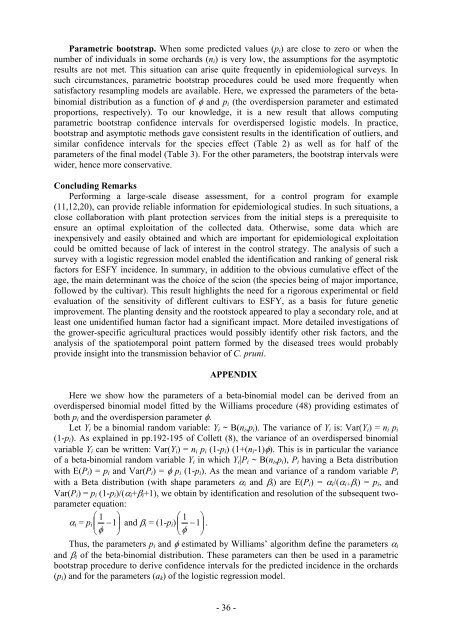Ecole Nationale Supérieure Agronomique de Montpellier ... - CIAM
Ecole Nationale Supérieure Agronomique de Montpellier ... - CIAM
Ecole Nationale Supérieure Agronomique de Montpellier ... - CIAM
You also want an ePaper? Increase the reach of your titles
YUMPU automatically turns print PDFs into web optimized ePapers that Google loves.
Parametric bootstrap. When some predicted values (pi) are close to zero or when the<br />
number of individuals in some orchards (ni) is very low, the assumptions for the asymptotic<br />
results are not met. This situation can arise quite frequently in epi<strong>de</strong>miological surveys. In<br />
such circumstances, parametric bootstrap procedures could be used more frequently when<br />
satisfactory resampling mo<strong>de</strong>ls are available. Here, we expressed the parameters of the betabinomial<br />
distribution as a function of φ and pi (the overdispersion parameter and estimated<br />
proportions, respectively). To our knowledge, it is a new result that allows computing<br />
parametric bootstrap confi<strong>de</strong>nce intervals for overdispersed logistic mo<strong>de</strong>ls. In practice,<br />
bootstrap and asymptotic methods gave consistent results in the i<strong>de</strong>ntification of outliers, and<br />
similar confi<strong>de</strong>nce intervals for the species effect (Table 2) as well as for half of the<br />
parameters of the final mo<strong>de</strong>l (Table 3). For the other parameters, the bootstrap intervals were<br />
wi<strong>de</strong>r, hence more conservative.<br />
Concluding Remarks<br />
Performing a large-scale disease assessment, for a control program for example<br />
(11,12,20), can provi<strong>de</strong> reliable information for epi<strong>de</strong>miological studies. In such situations, a<br />
close collaboration with plant protection services from the initial steps is a prerequisite to<br />
ensure an optimal exploitation of the collected data. Otherwise, some data which are<br />
inexpensively and easily obtained and which are important for epi<strong>de</strong>miological exploitation<br />
could be omitted because of lack of interest in the control strategy. The analysis of such a<br />
survey with a logistic regression mo<strong>de</strong>l enabled the i<strong>de</strong>ntification and ranking of general risk<br />
factors for ESFY inci<strong>de</strong>nce. In summary, in addition to the obvious cumulative effect of the<br />
age, the main <strong>de</strong>terminant was the choice of the scion (the species being of major importance,<br />
followed by the cultivar). This result highlights the need for a rigorous experimental or field<br />
evaluation of the sensitivity of different cultivars to ESFY, as a basis for future genetic<br />
improvement. The planting <strong>de</strong>nsity and the rootstock appeared to play a secondary role, and at<br />
least one uni<strong>de</strong>ntified human factor had a significant impact. More <strong>de</strong>tailed investigations of<br />
the grower-specific agricultural practices would possibly i<strong>de</strong>ntify other risk factors, and the<br />
analysis of the spatiotemporal point pattern formed by the diseased trees would probably<br />
provi<strong>de</strong> insight into the transmission behavior of C. pruni.<br />
APPENDIX<br />
Here we show how the parameters of a beta-binomial mo<strong>de</strong>l can be <strong>de</strong>rived from an<br />
overdispersed binomial mo<strong>de</strong>l fitted by the Williams procedure (48) providing estimates of<br />
both pi and the overdispersion parameter φ.<br />
Let Yi be a binomial random variable: Yi ~ B(ni,pi). The variance of Yi is: Var(Yi) = ni pi<br />
(1-pi). As explained in pp.192-195 of Collett (8), the variance of an overdispersed binomial<br />
variable Yi can be written: Var(Yi) = ni pi (1-pi) (1+(ni-1)φ). This is in particular the variance<br />
of a beta-binomial random variable Yi in which Yi|Pi ~ B(ni,pi), Pi having a Beta distribution<br />
with E(Pi) = pi and Var(Pi) = φ pi (1-pi). As the mean and variance of a random variable Pi<br />
with a Beta distribution (with shape parameters αi and βi) are E(Pi) = αi/(αi+βi) = pi, and<br />
Var(Pi) = pi (1-pi)/(αi+βi+1), we obtain by i<strong>de</strong>ntification and resolution of the subsequent twoparameter<br />
equation:<br />
⎛ 1 ⎞<br />
⎛ 1 ⎞<br />
αi = pi⎜<br />
−1⎟<br />
and βi = (1-pi) ⎜ −1⎟<br />
.<br />
⎝φ<br />
⎠<br />
⎝φ<br />
⎠<br />
Thus, the parameters pi and φ estimated by Williams’ algorithm <strong>de</strong>fine the parameters αi<br />
and βi of the beta-binomial distribution. These parameters can then be used in a parametric<br />
bootstrap procedure to <strong>de</strong>rive confi<strong>de</strong>nce intervals for the predicted inci<strong>de</strong>nce in the orchards<br />
(pi) and for the parameters (ak) of the logistic regression mo<strong>de</strong>l.<br />
- 36 -



